2019 Performing Arts Market in Seoul(PAMS)
Delegates Round-Table Talks (2)
‘Children’s Theater of Korea: A Shortcut to the Global Scene’
Introduction
Suk-hee Kim (Artistic Director / Jongno Children’s Theater)
Over the past few years, Korea’s diverse institutions have increasingly taken interest in children’s theater. That may be because the theater’s social, educational and artistic influences on young audiences have been proven recently.
Indeed, the number of international performing arts companies that present performances for children at the Performing Arts Market in Seoul(PAMS) has steadily increased year after year. In 2019, numerous overseas teams came to seoul with a great deal of materials promoting themselves. Although the priority of PAMS is to help Korean performances go global but ironically, it was difficult to find Korean teams’ booths. Several years ago, some theater companies for children had their booths but this year, I wasn’t even able to see those making even the smallest efforts to promote themselves. I’m concerned that they haven’t achieved any concrete result, that they have been disappointed with their overseas performances or that they have experienced some problems when networking with overseas partners.
Some would ask, “Is it that important to go global?” My conclusion is that to us, going global is very important. I have encouraged theater companies for a long time, ceaselessly explaining why Korea’s theater for children needs to go global. There are so many reasons why it needs to do so but I will share only the most important ones.
First, Korea has a small territory so there is a limit to the domestic demand for performances. Second, the number of children aged 12 years or younger is half of that of ten years ago while the number of theater companies continues to increase, resulting in overheated competition. Under these circumstances, it is difficult to expect the qualitative improvement of performances. Third, there is almost no country or city without performing arts festivals for children. Fourth, many countries are upgrading the format of their festivals to globalize them. Consequently, children’s theater has much more opportunities to go global than performances for adults. In other words, we have a blue ocean ahead of us, under the condition that Korea’s performances for children are globally recognized as high-quality ones.
TheApro Round-Table Talk with People in the children`s theater Scene (October 10, 2019 / Café Jang)
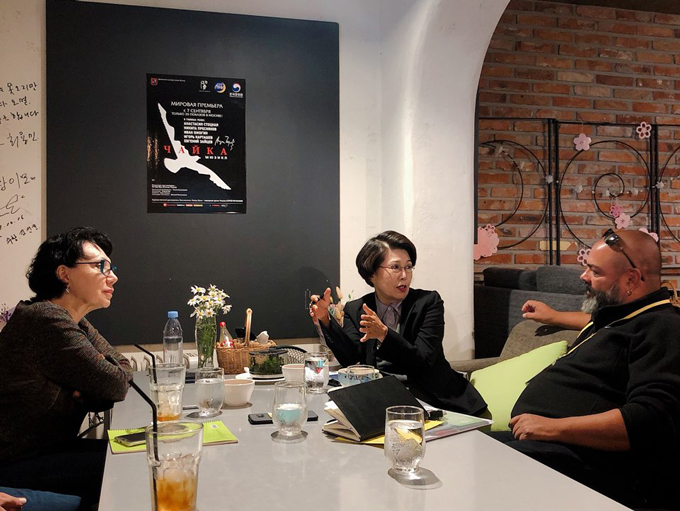
2019 PAMS Delegates Round-Table Talks (Tereza Durova, Suk-hee Kim, Jeremy Boomer Stacey)ⓒKAMS
Moderator: Suk-hee Kim (Artistic Director / Jongno Children’s Theater)
Translator(Korean-Russian): Sang-jun Kim (Freelancer)
Participants (In alphabetical order)
Jeremy Boomer Stacey (United States / International Performing Arts for Youth(IPAY) / Executive Director)
Tereza Durova (Russia / Gavroche Festival / Artistic Director)
For those working on the theater for young audiences in Korea, PAMS 2019 had a round-table talk with two internationally recognized guests specializing in performing arts for youth. It was a meaningful occasion to share information on relevant festivals and markets. The invitees are Boomer Stacey, executive director of the International Association of Performing Arts for Youth (IPAY), and Tereza Durova, artistic director of the Gavroche International Festival in Moscow, Russia.
To begin with, I will share what I talked about with Tereza Durova, artistic director of the Gavroche International Festival in Moscow, Russia. The festival aspires to a revolution in performances and theaters to the point that it was named after Gavroche, a boy symbolizing the French Revolution in Les Misérables by Victor Hugo. Just as its name suggests, the festival has presented performances of a variety of genres such as ballet, the circus, the theater and puppetry for the past thirteen years.
Suk-hee Kim: My first question is if the Gavroche International Festival was initiated by the government or the private sector.
Tereza Durova: At first, the festival was led by the private sector but later on, its organizing committee requested government support. Today, it is a public festival financially supported by the city of Moscow. The Teatrium in Serpukhovka, which is in charge of running the festival, also started as a private theater in 1991 but it later became a national one, thus making itself eligible for initial financial support from the city of Moscow and Russia’s Ministry of Culture. The Teatrium in Serpukhovka, where I’m serving as the artistic director, is Moscow’s largest theater for children. That is why I proposed to the city of Moscow and the Ministry of Culture the launch of the Gavroche International Festival focused on performing arts for youth. The first Festival was greatly helped by France’s Ministry of Culture and the French Embassy.
When we select a Focus Country and prepare invitation, the first institutions we contact is the Focus Country’s embassy and cultural center. Indeed, the most important support comes from the Focus Country’s institutions because what is essential is not only collaboration based on mutual benefits but also the Focus Country’s interest in Gavroche. For example, the Festival selected Germany as its Focus Country in 2012 and 2018 and was supported by the Goethe Institut. The Festival provides overseas performing arts companies with accommodation, performance fees and theater rental while the Focus Country supports the Festival with airfares and freight costs. Every year, we additionally rent seven or eight performance venues and invite on average eight to ten performances of the Focus Country. In 2015, we even invited thirteen performances of Poland, the Focus Country of the year.
The Teatrium in Serpukhovka. which serves as the Festival’s main venue, has a large theater of 1,000 seats and a small one of 300 seats. The theaters are open from Friday to Sunday. In Moscow, we present performances for children only on Friday, Saturday and Sunday. In Korea, children come to theaters in groups with those going to the same school or kindergarten but in Moscow, they come only with their family. That is why we open theaters for children only on these days when children don’t go to school or kindergarten.
Suk-hee Kim: I’m also curious about the true goal of the Festival. Is it to help children develop their artistic sensibilities? Or, is it to educate them through performing arts?
Tereza Durova: For a performing arts festival, its educational goal for children is essential. So during the Festival, we run cultural programs in addition to performances so that visitors can experience another culture. For instance, we offer master classes teaching how to play another country’s musical instruments or we also talk about anthropogeography. If we talk about Seoul with the audience, we could show them a map and indicate the route from Moscow to Seoul on it. We could also play diverse games related to Korean culture.
In Moscow, there are many people from different countries including Korea. Our theater’s young visitors love to attend performances while wearing a headset for translation. They are so used to the headset that they even explain to their parents what is going on while wearing it. Like this, children are allowed to talk to their parents during a performance. If there aren’t many lines in a script, an interpreter provides simultaneous interpreting on stage so children don’t find it difficult to watch foreign performances. Moreover, nonverbal performances of genres like ballet and music don’t even need translation. We offer such a variety of genres, resulting in a very beautiful literary picture.
Suk-hee Kim: Russia and the post-Soviet states mostly have large theaters of 800 to 1,000 seats rather than smaller ones. It is at these large theaters that they present performances for children. The goal of performances for children is to communicate with young audiences so that they can grow culturally. I believe that the optimum size of a theater that enables us to communicate with children is between 150 and 200 seats. Performances at too large theaters would make them think that they are in a movie theater. Could you tell me what effects you expect as you present performances for children at a large theater?
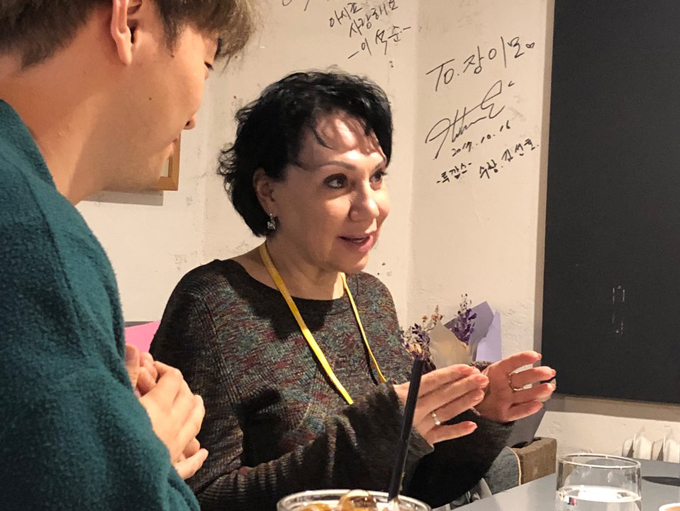
2019 PAMS Delegates Round-Table Talks / Tereza Durova (Russia / Gavroche Festival / Artistic Director) ⓒKAMS
Tereza Durova: The Teatrium in Serpukhovka is a large theater of 1,000 seats but you can see the stage well from any seat in the theater. Performances staged at the large theater are mostly very expensive so they need many spectators. That is because a large number of actors perform on stage with an orchestra. On the other hand, we present performances for children aged five to six at the smaller theater of 200 or 300 seats. We also offer performances for infants aged two to three at a studio with a capacity of 20 children and 20 parents. It is the performance producer that chooses a performance venue. When we produce a performance, we consider the age of the audience.
Suk-hee Kim: I would also like to know if the Teatrium in Serpukhovka belongs to an individual or to the country.
Tereza Durova: The Teatrium in Serpukhovka is also called the Tereza Durova Theater in my name. The theater building belongs to an individual but its management is supported by the government.
Suk-hee Kim: I’m aware that the Gavroche International Festival focuses on one country and presents ten or thirteen performances from that country. Do you have criteria for selecting the Focus Country? The year 2020 marks the 30th anniversary of the diplomatic ties between Korea and Russia so you selected Korea as the Focus Country of that year. Meanwhile, France was selected as the Focus Country several times and as for Germany and the Netherlands, twice. Could you explain why you select certain countries more than once?
Tereza Durova: I first found it interesting to see those in the international performing arts scene recommend Korea’s performances for children. I would like to invite about eight of the 20 performances I watched. When it comes to selecting the Focus Country, it would be best to invite a country on a special occasion as in the case of Korea in 2020. But even if there is no such special occasion, we tend to invite countries with many high-quality works worth inviting. For example, once we invite Korean performing arts companies to the 2020 Festival and we build a friendly relationship with the country’s artists, we could be friends in two to three years and know how Korean artists work. At that time, if Korean artists introduce new companies and works, Gavroche could review their recommended performances and choose high-quality ones to introduce Korea’s performing arts for children once again.
Suk-hee Kim: Does Russia also have an arts market for children like PAMS? Another question is about your first impression of PAMS since it is your first visit to Korea and to PAMS.
Tereza Durova: Russia has neither performing arts market for children nor higher education institutions teaching performing arts for youth. I came to PAMS this year to meet performing arts companies from different countries and to introduce to them the Gavroche International Festival. I hope to visit PAMS again next year because more friends lead to more exchanges and better atmospheres.
After the talk with Tereza Durova, I talked to Boomer Stacey, executive director of the International Association of Performing Arts for Youth (IPAY).
Suk-hee Kim: The International Association of Performing Arts for Youth (IPAY) is the world’s largest arts market for children and young people. Could you explain when it was launched, who founded it and to which country it belongs (Canada or US)?
Boomer Stacey: IPAY was launched in Chicago, US in March 1979 so it has just celebrated its 40th anniversary. It all started with programmers who were looking for performances for the family season and presenters who failed to find performing arts companies. At that time, they made a showcase together. I don’t know the name of everyone who participated in the founding of IPAY but I know some of them including North American presenters like Brian Joyce from the Philadelphia International Children’s Festival. At the beginning, it was very informal and every year, presenters took turns to run IPAY. It then became a tradition to organize the event every year in a different city.
Suk-hee Kim: So IPAY is an institution belonging to the US.
Boomer Stacey: It is based in the US but it is an international organization. I’m Canadian and I’m serving as its director and most of its staff members are from Philadelphia. Its board of directors has international experts from Australia, Canada, the Netherlands and the US. So the association is very global and is trying to be very global.
Suk-hee Kim: Do you have any Asian staff members?
Boomer Stacey: We have Asian staff members and we also had a Chinese member in our Selection Committee.
Suk-hee Kim: I have worked on children’s theater for about 30 years. I hadn’t known much about IPAY but as it began to run a performing arts market for youth in 1998, its name became visible suddenly.
Boomer Stacey: At first, IPAY was run mostly by volunteers and it didn’t have any employees. As I started serving as its director in 2012, I came to promote IPAY actively. I also visited overseas arts markets and festivals to let them know what IPAY is doing. I’m also investing a great deal of time in developing relationships with other countries and arts and culture institutions. I believe that the association has been able to develop rapidly compared to the period when it was run mostly by volunteers. It is difficult to go global so most of our activities were focused on North Korea at the beginning.
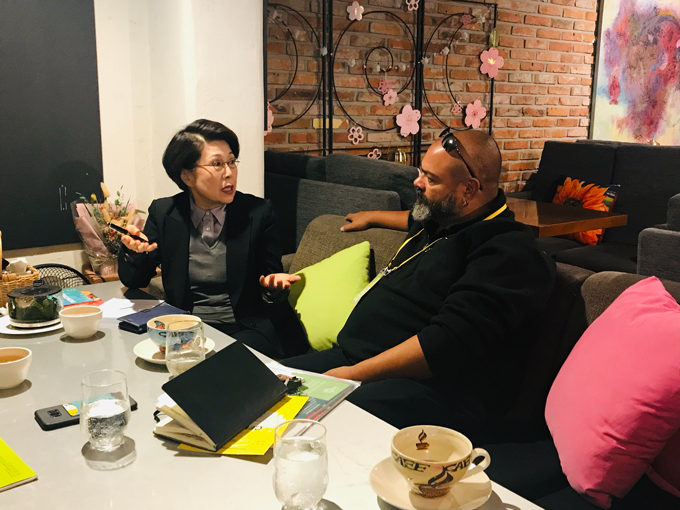
2019 PAMS Delegates Round-Table Talks / Suk-hee Kim, Jeremy Boomer Stacey (United Sates / IPAY /
Executive Director) ⓒKAMS
Suk-hee Kim: Personally, I don’t like “arts markets” very much because they are too crowded and they don’t give me enough time to reflect on something. On the other hand, festivals allow us to fully enjoy performances and to network. Compared to festivals, arts markets are more like business events.
Boomer Stacey: I agree. But what differentiates IPAY from other markets is the fact that it works for “children.” Participants of IPAY are special groups of people who are interested in performances for youth. That is why unlike other overseas arts markets, IPAY has a point connecting its participants as one. To those in children’s theater scene, what is critical is the belief that they are doing the same work together, rather than specific platforms like festivals, meetings and markets. It is this belief that makes them work with enthusiasm.
If other overseas arts markets are supermarkets, IPAY is trying to be farmers’ market. It means that IPAY isn’t a place where participants find the products they want on shelves but the one where they find something unexpected and new. It is the market IPAY pursues. Since it is smaller than other arts markets, its participants enjoy themselves together just as they are in a family gathering. At IPAY, what is important is how participants build relationships, why they do their work and what stories are discussed mainly, rather than selling performances. Although IPAY is an market, it is making efforts to strengthen its function of sharing participants’ “ideas,” “information” and “challenges.”
Suk-hee Kim: Could you tell me about the structure of IPAY’s market? How many booths do you have?
Boomer Stacey: We have 15 full-length performances, 15 excerpts called “Spotlights” and Off IPAY where participants perform freely just like during a fringe festival. We also have about 80 booths run by performing arts companies and cultural institutions.
Suk-hee Kim: As for children’s theater companies from Korea, I know that Brush Theatre participated in IPAY several times. But most of Korean companies don’t have much information on IPAY so they are curious about how to participate in it.
Boomer Stacey: It is actually very simple to get information on IPAY. I personally consider it best to share information by forming collaborative relationships with arts and culture organizations or institutions. For example, when we invite a Dutch company, I ask them to share information on IPAY. So during this year’s PAMS, I’m trying to find a partner institution that could share information on IPAY like KAMS.
Suk-hee Kim: I also want to know if there is any concrete data of successful results that were achieved after performing arts companies’s participation in IPAY’s arts market.
Boomer Stacey: We don’t have any academic research or surveys on the results of their participation in our arts market. Of course, doing academic studies is on IPAY’s wish list. IPAY has a very small number of employees but it has built a network with performing arts companies from different countries for the past years. Companies participating in our arts market can have annual tour opportunities through their booths or performances.
Suk-hee Kim: Could you explain what kind of financial support the American or Canadian government is providing for the management of IPAY?
Boomer Stacey: We don’t receive any government support. The US doesn’t have any policy on subsidizing arts and culture orgainzations like IPAY. We can request support for the cost of running our projects but we aren’t sure if we will be able to benefit from such support. So IPAY’s finance is from membership fees at 100%.
Suk-hee Kim: Who are the members of IPAY and what are their benefits?
Boomer Stacey: IPAY is an institution run through membership. So if you want to be eligible for the rights and benefits IPAY offers to its members, you need to pay the annual membership fee ($250 to $650). The entire amount they pay to participate in our arts market’s showcases is used for running the showcases. IPAY is actually a poor association. Its board of directors, which is in charge of setting its main direction, has 17 members.
Suk-hee Kim: I’m aware that Brush Theatre will participate in IPAY’s official showcase in 2020. Could you explain who selects showcase performances?
Boomer Stacey: This year, other Korean companies applied for the showcase but only Brush Theatre was selected. A total of 120 companies applied for IPAY’s official showcase but only 30 of them were selected. Twelve jurors from different countries participate in selecting showcase works. They watch all the performances of the applicants before selecting the ones for the official showcase. Their esthetic tastes vary greatly so each of them chooses performances in different styles.
Suk-hee Kim: Do you mean that they don’t consider the characteristics of American or Canadian companies?
Boomer Stacey: We do consider North American traits but it is critical to accept outside views and esthetics. So we try to form relationships with more people outside North America. We also make efforts to find partners outside Europe. Indeed, Europe played a leading role for a long time. So today, we are willing to look for different stories and styles in Asia, Africa and South America.
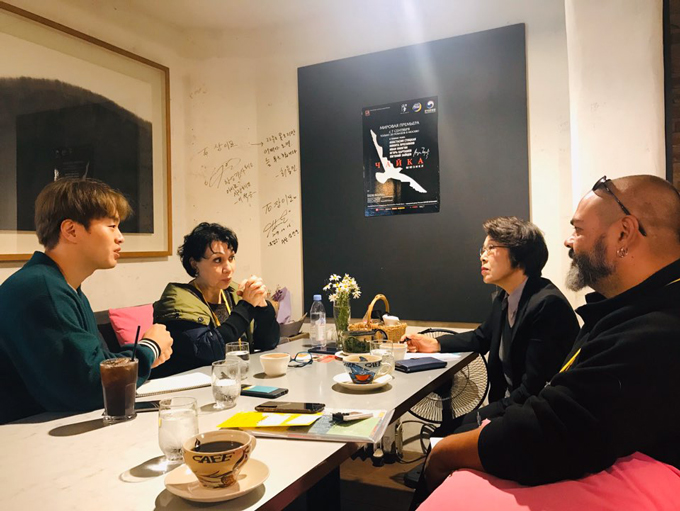
2019 PAMS Delegates Round-Table Talks (2): ‘Children’s Theater of Korea: A Shortcut to the Global Scene’
ⓒKAMS
Suk-hee Kim: How would you define IPAY? Is it closer to a business market or to an arts project?
Boomer Stacey: I believe that IPAY is both a business market and an arts project. And we need both. Since performing arts companies invest lots of money to seize touring opportunities, a market needs to be a dynamic business space. Distribution of performances is also crucial. Meanwhile, I also believe that a market’s role of invigorating the arts is equally important.
IPAY attracts not only visitors from North America but also artists from around the world. They come to IPAY to watch performances for young audiences and to be inspired by them. That is why the market also becomes a meeting place for them to exchange ideas. In my view, it is very important for a market to enable international participants to share their perspectives. IPAY is growing to be with global experts. Last year, we had participants from Asia, Africa, South America, North America and Europe.
Suk-hee Kim: As you mentioned, many Asian countries have great artistic values but they lack financial support to participate in IPAY. Are you trying to introduce developing countries to IPAY? Do you have any plan for this?
Boomer Stacey: I agree that it is an important point. But IPAY isn’t receiving any financial support so the problem is how to do it. We are trying to find cultural organizations that could collaborate with us and to build relationships with them.
Suk-hee Kim: In some special cases, international organizations like the Institut français and Goethe-Institut provide artists from developing countries with financial support but arts companies lack information.
Boomer Stacey: IPAY can share information for them. Among IPAY’s showcase programs, a network platform called “Kindling” greatly contributes to sharing information. Kindling refers to the smallest pieces of wood that you use to start a fire. If you want a big fire, you could start with Kindling. At IPAY, Kindling is a means that allows its participants to activate their discussion and to share information. We hope that Kindling leads to a larger fire. Those who participate in Kindling actually develop other networks and ideas.
Suk-hee Kim: I would be great if IPAY could contribute to an exchange program for children’s theater as in the case of the Erasmus Programme established by the EU.
Boomer Stacey: IPAY is also making efforts to collaborate with other countries’ institutions in an attempt to build a global partnership like Europe’s Erasmus Programme.
Suk-hee Kim: Not only Europe but also Asia and developing countries could establish such an international cooperation program. Nevertheless, it is also true that such a project requires a pioneer who would take the lead in cooperation.
Boomer Stacey: That is why it is important to visit PAMS, to form new relationships with other countries’ institutions and companies, to find good partners and to think about how to work with them. We participate not only in children’s theater festivals in Europe but we also visit festivals and markets in other regions like Asia and South America to build new relationships. In this way, we are trying to differentiate ourselves from ordinary market-type festivals. But a relationship isn’t something we can build during one-day trip to such events. It takes time and efforts to build it.
Suk-hee Kim: I want you to remember that Asia is the biggest continent on earth and that it has the largest population of children. I personally believe that Asia constitutes the largest market in the world. Asian children also need to improve their cultural level through plays.
Boomer Stacey: That is why I believe that there will be many opportunities of exchange in Asia. Indeed, theaters in many North American cities also have a great number of Asian visitors. In all major North American cities like New York, Boston and Toronto, Asians consider it important to watch performances from their home. So it is important for North American presenters to bring works for them. But it is easier said than done so we need to come up with a system supporting this.
Suk-hee Kim: It seems that those from Europe use the terms “showcase” or “platform” rather than “market.”
Boomer Stacey: It is just a matter of how to package the content and the basic idea is the same. That is because our purpose is to provide a “venue” for selling performances.
Suk-hee Kim: Between Europe’s festivals and arts markets, what would you recommend for business purposes?
Boomer Stacey: Both festivals and arts markets are interesting. It would depend on your specific purpose of participation. For example, if you want fresh vegetables, you go to a store selling them and if you want a TV you need to go to a TV shop. Programmers need to understand what visitors want and what performances to invite through what kind of connection. In my personal view, Toronto’s festivals prefer small and dark creative performances in the style of Dutch or Flemish esthetics. But there are also other North American presenters who prefer fairy tale-based ones or larger ones.
IPAY is a market where those who want all of these styles meet each other. So it is not easy to understand everyone’s needs. Consequently, IPAY presents performance programs of all genres: large and small performances, the circus, puppetry and music.
Suk-hee Kim: I don’t know if I could say this but these days, some of those in the performing arts scene in Europe and North America seem to regard the Chinese market not as a venue of exchanging human resources but as a “large business market.” I personally feel regrettable about that.
Boomer Stacey: I agree. As you may know, we don’t make lots money by running an arts market. In most cases, we do it on the basis of mutual trust. So I feel a little hollow when considering such characteristics of arts markets. But I do understand why people engage in such aggressive marketing. Of course, I personally believe that relationships, exchanges and in-depth stories of different cultures are important. But thinking from the perspective of institutions or companies, I do understand why some of their members focus on selling their shows.
Suk-hee Kim: I believe that those working on children’s theater should be a little different from those presenting performances for adults. Nevertheless, children’s theater seems to be following the international trends of the performing arts market.
Boomer Stacey: I think that IPAY is more successful than other markets for some reasons. First, IPAY knows that it is different from other performing arts markets for adults. So arts and culture institutions don’t treat IPAY in the same way as they do for other arts markets. They understand that IPAY is different from other markets and that it works in a different way. Performances for children are different from those for adults and their tickets are five dollars, not 100 dollars. In addition, it is not children but adults who choose performances children will watch. Such differences seem to make IPAY special.
Suk-hee Kim: Concerning the reality faced by Korea’s performances for children, people aren’t willing to compare the differences of Asian countries. Not many improvements had been made when I recently visited a festival in Europe. So it seems to be time to turn our eyes to Asian cultures but it is unfortunate that nobody is taking the lead.
Boomer Stacey: I believe that people’s ideas about Asia are changing. Of course, it is not a short-term change but the one based on long-term relationships. Among IPAY’s showcase programs, there is the one called “Cultural Spotlight” where we focus on a country’s arts and culture. To us, what is important in running this program is to focus on the context of the country. For example, Korea is a very small country but it has numerous performing arts companies for young audiences that could show their diversity through the very different styles of Brush Theatre and Masil Theater.
Suk-hee Kim: Lastly, could you tell me about your first impression of PAMS and about what made you participate in PAMS?
Boomer Stacey: It is my first visit to PAMS. During the visit, I was able to meet many people in the performing arts scene. Compared to European festivals or the General Assembly of ASSITEJ, PAMS enabled me to form more new relationships and I believe that it is a very different network. I like ASSITEJ but during that event, I always meet the same people so they are like my family. But PAMS gave me a different opportunity to meet people and works of the arts and culture in different fields. It would be better if it presented more performances for youth but I’m thankful for all the diversity I was able to experience at PAMS.








 PREV
PREV
.jpg)
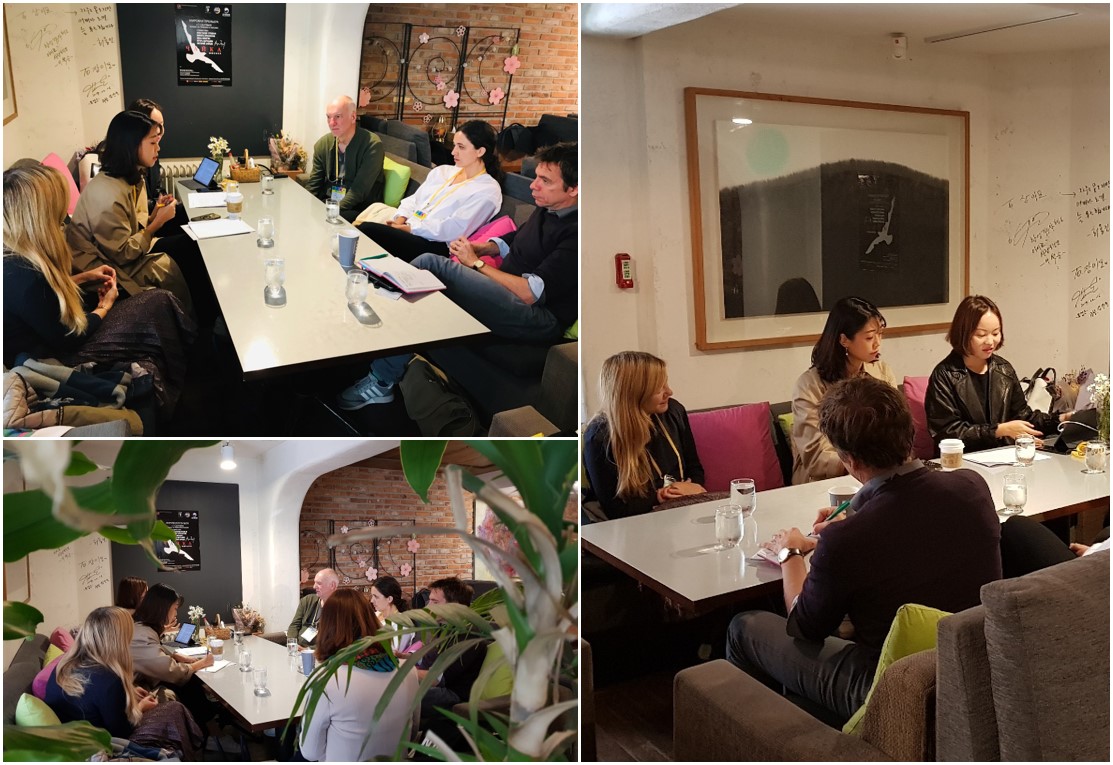
.jpg)
.jpg)
.jpg)
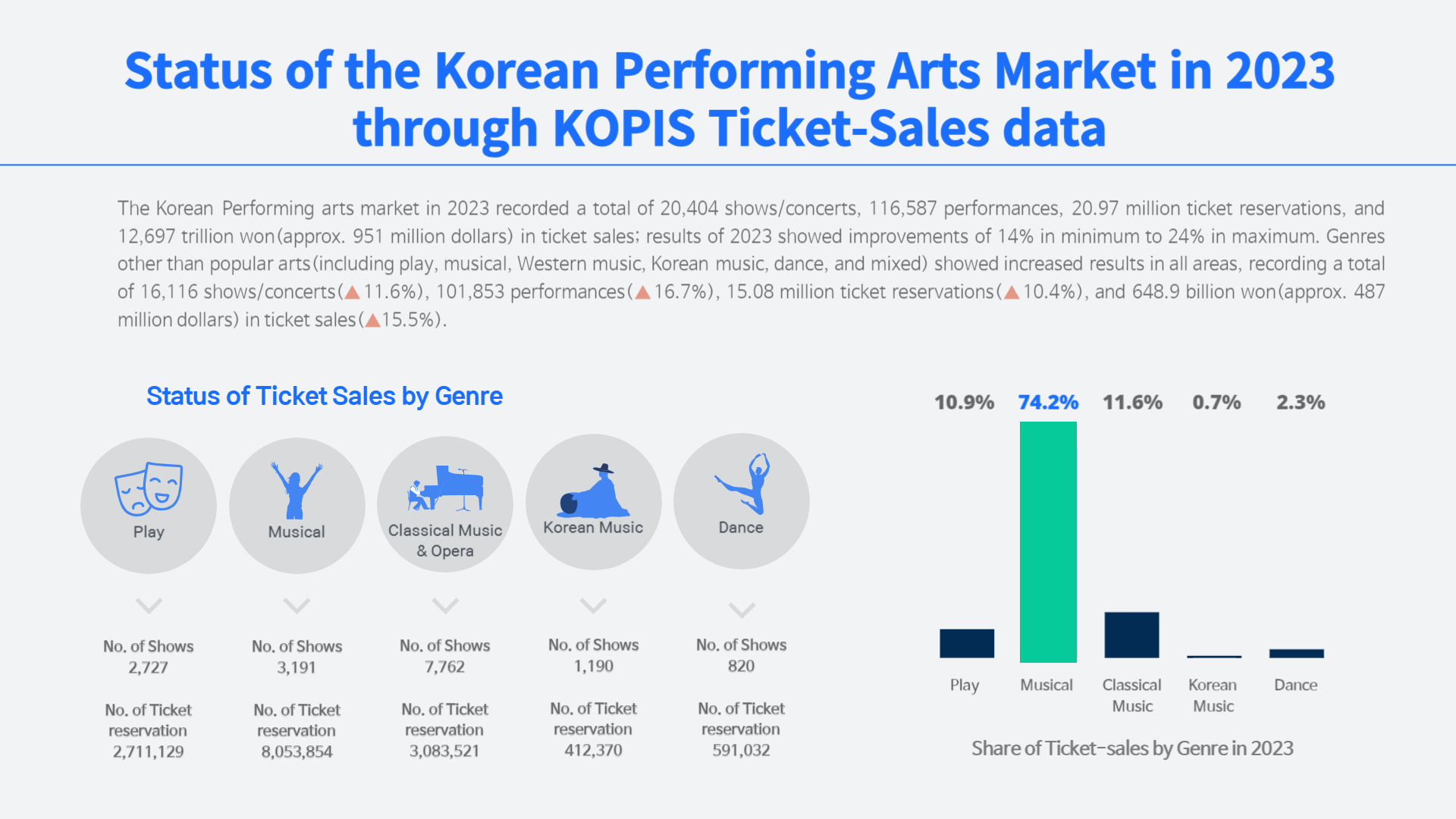
.jpg)
.jpg)
.jpg)
.jpg)











